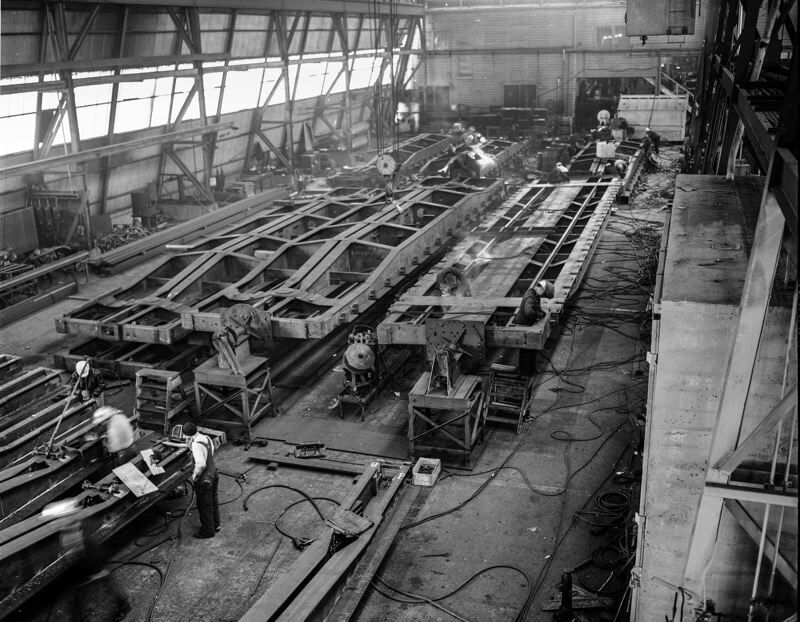Gunderson at 100: Built to last Riding high at 100
Published 12:00 am Tuesday, February 5, 2019

- Hugh Ackroyd spent more than 60 years photographing the daily operations at Gunderson.
During a typical day at Gunderson’s riverfront manufacturing facility in Northwest Portland, sparks fly as workers in the company’s marine division weld together panels on the bow of an oceangoing barge.
Trending
A cloud of steam rises from a machine clearing a wax coating off wheels destined to become part of the rail cars that make up a significant portion of the company’s work.
An overhead crane whirs as it transports a piece of steel from a pile to a nearby assembly area. Add in the clanks and bangs of machinery and metal and the result is a symphony that the company has been composing for the past 100 years.
These days, Gunderson operates as a division of Greenbrier Cos. From its location at 4350 N.W. Front Ave., the company focuses on two main areas of manufacturing.
Trending
Its rail car division turns out both boxcars and a double-stack design. The latter has been an especially strong product for Gunderson and its parent company.
“We’ve got a 60 percent market share in that car type,” said Mark Eitzen, Gunderson’s general manager.
Meanwhile, the marine division is flourishing, with the company preparing to start work in a few months on the largest articulated tug barge it has ever tackled.
A solid backlog of work has the company facing its future in a strong position, but success hasn’t always been easy to come by. In reaching the century mark, Gunderson has had to tap a reservoir of innovation and business savvy to survive a major economic depression, several recessions, market shifts, skilled worker shortages, and two acquisitions.
In the beginning
Gunderson’s start can be traced to Seattle and a man named Chester “Chet” Gunderson. Born with the heart of an entrepreneur and a head for business, Gunderson opened a small electrical contracting company in 1914, but soon shifted gears, turning a love of motorcycles into a business repairing them. Before too long, Gunderson and two partners found themselves in demand for their expertise in fixing wood-spoke and wire wheels for cars and trucks.
By 1919, Gunderson had left his partners behind. He moved to Portland and opened a sole venture called Wire Wheel Sales and Service Co. Four years later, his brother,” Alvin “Al” Gunderson, brought his talents as a salesman to the business.
Together, the brothers moved through a series of business ventures, including a failed attempt in the fertilizer business, until they found some success in building truck trailers.
In the late 1930s, working in the community of Linnton, north of Forest Park, they designed a hub system that drew positive attention. In order to manufacture their new product, they formed a company called Gunderson Bros.
The company held the name as it shifted into ship building — and moved to its current riverfront location — in the early 1940s. After World War II ended, the company transitioned to building barges.
Market shifts convinced the Gundersons to work on one-time projects, turning out bridges and gates for dams, tugs, barges and water tanks. When those projects began to dry up, the brothers once again went looking for new markets to dip into. They found one when they received an order for 150 rail boxcar underframes. The company’s success in that market eventually caught the eye of FMC Corp., a national company that in 1981 acquired the business and changed the name from Gunderson to FMC Marine & Rail Division.
The company found itself with a new owner in 1985, when Greenbrier Cos. purchased it from FMC. Greenbrier, an Oregon company that got its start in Oregon City and now has its headquarters in Lake Oswego, decided to reunite its new acquisition with its original name.
Since becoming a division of Greenbrier, Gunderson has remained the parent company’s only manufacturing facility for marine vessels. It also holds the distinction of being the first rail car manufacturing shop.
Greenbrier has since added three rail car factories in Mexico, and one each in Brazil, Romania and Poland, as well as a joint venture operation in Turkey. There also are several repair facilities for rail cars throughout North America, along with some shops where wheels are manufactured. The company also provides car scrapping services for its rail customers.
“Greenbrier does pretty much everything from birth to death for rail cars,” Eitzen said.
Record numbers
While most companies choose to celebrate a century in business with cake and balloons, Gunderson is marking the occasion by beefing up its work force. Even though the company has automated portions of its operations, it still needs skilled workers, from welders to robotics technicians.
The company’s marine division will begin work in a few months on a 581-foot, ocean-ready articulated tug barge that will have a capacity to carry 208,000 barrels of crude oil or petroleum at a time. Once that vessel — the largest barge the company has tackled — is completed, Gunderson will turn around and start building a second barge with the same specifications.
Meanwhile, the rail division is seeing nearly triple the orders of one year ago.
“On the rail car side at this time last year, we were at six cars a day,” Eitzen said. “Now we’re at 16 a day.”
Picture perfect
If a picture is worth a thousand words, photographer Hugh Ackroyd built an entire library’s worth of history for Gunderson in the 60-some years he spent visually documenting the company.
Ackroyd began his career in photography in Canada while in his teens before working as a celebrity portrait photography in Hollywood in the 1930s. He shifted to industrial photography after moving to Oregon, picking up Gunderson as a client in 1946.
While Ackroyd worked for other Oregon companies during the ensuing years, with an emphasis on industrial and aerial photography, he focused such a large part of his time capturing the story of Gunderson in pictures that the earned the title as the company’s photographer of record.
Ackroyd’s photographs for Gunderson don’t just include a record of every rail car and marine vessel the company built over the years. He photographed Gunderson executives, clients and employees at work and at play. He captured weddings and funerals. He even photographed the company’s role in making sure the Portlandia statue made it safely to her final resting spot in downtown Portland.
Even as he reached his 90s, Ackroyd continued to serve as Gunderson’s main photographer, showing up for shoots dressed in a business attire that included his signature bow tie and sweater vest.
In 2007, Ackroyd’s Gunderson images were compiled in a book. The photographer died in 2012 at the age of 99.
More online
Go to PortlandTribune.com for:
• All in the family: Some families have worked at Gunderson for generations.
• Glocal trade storms buffet the Oregon company.
sbasalyga@pamplinmedia.com







